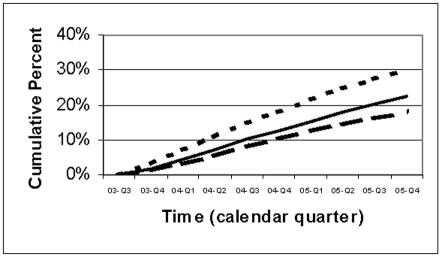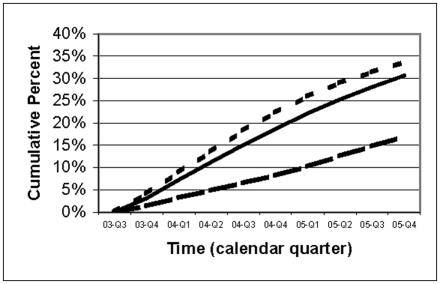Objective
This work describes variations in adoption rates of a comprehensive patient web portal within demographic and health-status defined subgroups. It also explores effects on adoption rate calculations of alternative definitions of adoption.
Setting
Group Health Cooperative is a mixed-model Health Maintenance Organization based in Seattle, Washington. The MyGroupHealth (MyGH) patient web portal was expanded in July 2003 to offer a comprehensive set of services integrating selected components of Epic MyChart® software plus existing locally-developed components, including a shared electronic medical record, secure patient-provider messaging, medication refills, lab results, health assessment tools, and the Healthwise® knowledge base. Enrollees receiving care in the integrated delivery system are eligible to use the portal.
Methods
Age, gender and continuous enrollment were established using automated administrative data. Morbidity level was estimated using the Johns Hopkins ACG® Case-Mix System Software on diagnosis codes associated with utilization in 2004. Low morbidity was defined as an ACG® RUB score of 0–2 (nonusers, healthy users, and low morbidity). A RUB score of 3 (moderate morbidity) defined the moderate group, and scores of 4 or 5 (high morbidity or very high morbidity) defined the high morbidity group. Detailed portal usage data were obtained from an Epic Clarity® database tracking enrollee access to 17 distinct MyChart® service/content areas. Two definitions of portal adoption were used: 1) initial adoption was defined as first portal usage of any type, 2) sustained adoption was defined as any type of portal usage in ≥ 2 separate calendar quarters. Cumulative adoption curves are based on the calendar quarter in which enrollees first met the specified definition of adoption. All subgroup analyses are based on sustained adoption.
Results
A total of 215,998 enrollees met age and continuous enrollment criteria. Morbidity levels were estimated for 201,543 (93%) of these. Cumulative initial adoption reached 33% in the 10th quarter; cumulative sustained adoption reached 26% in the same period. Adoption curves by both definitions were otherwise similar, and indicate strong growth in adoption over the 30-month period. Women were more rapid adopters than men reaching 28% and 24%, respectively, by the 10th quarter. We found differences in adoption rates by age group (Fig. 1), with the most rapid adoption observed among the 40–69 age group, reaching 30% in the 10th quarter, compared to 22% and 18% for the 18–39 and 70+ groups, respectively.
Fig. 1.
Sustained Adoption by Age Group: 40–69 (dotted), 18–39 (solid), and 70+ (dashed) years
The largest variations in adoption rates were observed among enrollees categorized by morbidity level (Fig. 2), where 34% of the high-morbidity and 32% of the moderate morbidity groups adopted portal use, compared to 17% for the low-morbidity group.
Fig. 2.
Sustained Adoption by Morbidity Level: High (dotted), Moderate (solid), & Low (dashed)
Conclusions
Patient adoption of web portals, as observed here, can vary substantially by demographic and health status characteristics of the eligible user population. Higher-morbidity, middle age, and female gender show the strongest positive associations with adoption. Observed adoption rates are influenced by the specific criteria used to define adoption.




